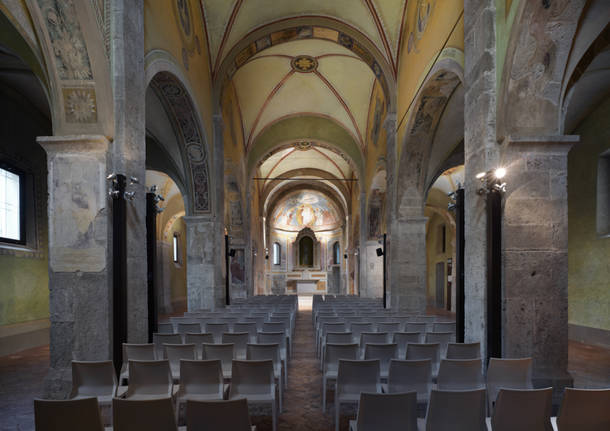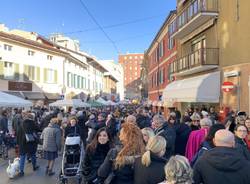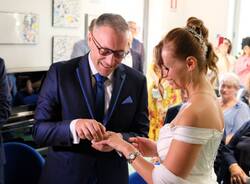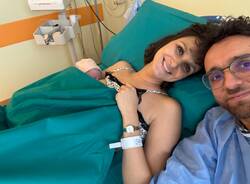The dynasty of restorers that make works of art shine again
From the Galleria Vittorio Emanuele to the Duomo, in Milan, the restoration work carried out by the company Gasparoli has given new life to buildings, churches and monuments, thanks to knowledge passed down from generation to generation.

Passing down their knowledge is something that is part of the Gasparoli family’s DNA. Art, technique and skill are what the generations who have led the Gasparoli company, which is specialised in the restoration and maintenance of cultural heritage, have passed down, since the second half of the 19th century. It is an inheritance of knowledge that today is in the hands of the brothers Marco, Guido and Paolo, and of Paolo’s son, Michele. The works restored by the Gallarate-based company can be seen by all. The job that has re-established their fame is the restoration of the Galleria Vittorio Emanuele, in Milan, a work, covering an area of 14,000 m2, of plaster, stones and stucco in the heart of the city.
Just like in the open-plan kitchens of great chefs, the Gasparoli restorers worked day and night, in full view. Every day, they cleaned, reinforced, stuccoed and restored, under the eyes of thousands of passers-by. The company also carried out work on the Duomo, on the Basilica of Sant’Ambrogio, on Alessandro Manzoni’s house, on Milan’s Central Station, on the Mole Antonelliana, in Turin, on the Basilica of Sant’Abbondio, in Como, and the Church of Santa Maria di Canepanova, in Pavia. Other work has been carried out in Varese Province, including the splendid restoration of the oratory built by the Visconti family in Albizzate.
“Our father taught us to pay attention, almost fanatically, to details and precision,” said the CEO, Guido Gasparoli. “The operator who carries out work, like in a sitting room (and the Galleria in Milan is the sitting room of the city), must do it with extreme care and leave it all clean after the work is done, guaranteeing beauty and preserving the identity and authenticity that make the monument unique and irreplaceable. That’s what we’ve tried to.”
It is no accident that, in the successful photographic exhibition by Marco Introini, “Ritratti di Monumenti” (“Portraits of Monuments”), which recently ended at the MA*GA Museum in Gallarate (it had over 3500 visitors), and which was dedicated to the most important work by this company, there are some pictures of work in progress. It is true that external appearance is still only a detail, but it is the details that make up the added value of the product and of the working process that this company can be proud of. Examples include the skill to reuse materials of the past, which results in more compatible and long-lasting interventions, the attention to quality and to the beautiful finishes, the respecting of deadlines, the independence and confidence in managing the work, the minimum margin of error, the collaboration with large architectural firms, to the knowledge needed to carry out scientific studies on the monuments to be restored.
Behind everything, there are highly qualified and enthusiastic operators, men and women whose skills have been refined with experience in the company, something reminiscent of what, in the past, might have been seen in the studios of the great masters. And like that golden age, also today, there is no shortage of results of virtuous choices.
“We have forty five employees, all with permanent contracts, and an extremely low turnover,” the CEO explained. “And for us, retaining the loyalty of our personnel and appreciating them are essential factors. There are a lot of willing young people beside long-standing, specialised operators, and the training is continuous, both on the preparation of the materials, and on the techniques used.”
“The manual work is the decisive part of our business,” Paulo, an architect and lecturer at the Polytechnic, added, “and we still follow a craftsman’s logic, when doing the work. But, unlike an artisan company, we have a structured organisation and complex technologies that are sometimes very sophisticated. We’re constantly looking for innovation, and we’ve recently been expanding our business abroad. This is made possible by digital technologies, which enable us, more easily, to be present, although not physically, in faraway locations.”
The country that almost has a monopoly on the world’s artistic heritage is not the only operating area, and unfortunately, it is common knowledge that, in Italy, the culture of prevention is often lacking. “Ministerial estimates tell us that there are about 500,000 buildings in Italy that are either subject to, or may, in the future, be subject to protection,” Marco Gasparoli said, “and for these, we wanted to invest in an alternative market to restoration, that of scheduled maintenance. We recently set up a part of the company that targets preventive maintenance. Thinking in terms of prevention would far better protect the cultural heritage, and do so with constant and repeated interventions that, consequently, are more effective and less expensive. Furthermore, any work on Italian cultural heritage is, in turn, an investment in culture. The research work, which is always necessary before restoration or maintenance, often opens the way to new discoveries or brings back stories and essential elements of our past. This too is the magic of our work, it leads to new knowledge that can increase the value of important works.”
La community di VareseNews
Loro ne fanno già parte
Ultimi commenti
Felice su Settimana della Sicurezza al Falcone di Gallarate: fuori presidi e polemiche "contro la militarizzazione"
Varese CdQ9 su Tra nuove norme e incertezze sui monopattini, anche a Varese si sperimenta il futuro della mobilità sostenibile
italo su Il rappresentante degli studenti si dissocia dalla protesta contro la Settimana della Sicurezza al Falcone
elena manfrin su "Ero inoperabile per tutti, ma non per il professor Ghezzi: grazie a lui sono rinata"
Giulio Moroni su È morto il fotografo Oliviero Toscani
italo su Il caso della contestazione alla "Settimana della Sicurezza" a Gallarate














Accedi o registrati per commentare questo articolo.
L'email è richiesta ma non verrà mostrata ai visitatori. Il contenuto di questo commento esprime il pensiero dell'autore e non rappresenta la linea editoriale di VareseNews.it, che rimane autonoma e indipendente. I messaggi inclusi nei commenti non sono testi giornalistici, ma post inviati dai singoli lettori che possono essere automaticamente pubblicati senza filtro preventivo. I commenti che includano uno o più link a siti esterni verranno rimossi in automatico dal sistema.